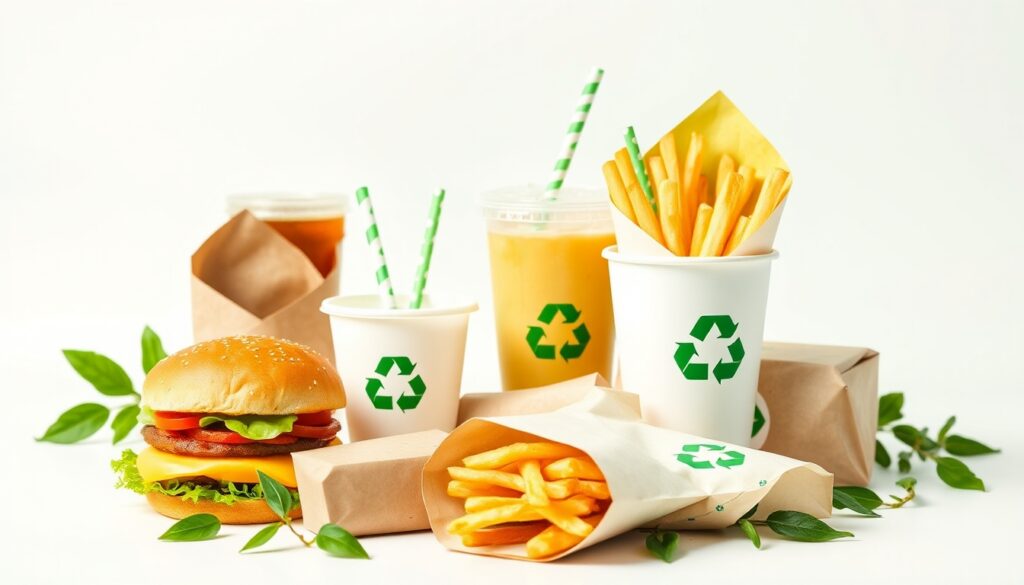Introduction:
sustainable fast food packaging: The increasing global awareness of environmental issues has prompted a significant shift in various industries, including the fast food sector.
As one of the world’s largest contributors to plastic pollution, the fast food industry faces immense scrutiny regarding its packaging practices.
Traditional packaging materials, particularly single-use plastics, not only contribute to environmental degradation but also pose threats to marine and terrestrial ecosystems.
In response to these challenges, the concept of sustainable fast food packaging has emerged as a crucial initiative aimed at minimizing environmental impact while maintaining the convenience that consumers expect.
This essay explores the significance of adopting sustainable packaging solutions in the fast food industry, highlighting their potential to reduce waste, promote circular economies, and enhance the overall sustainability of food service practices.

Table of Contents
1. The Need for Sustainable Packaging
Fast food packaging has long been a contributor to environmental degradation. With billions of meals served annually, the traditional use of plastic, polystyrene, and non-recyclable materials results in significant waste.
This waste often ends up in landfills, oceans, and ecosystems, leading to pollution and wildlife endangerment.
However, the fast food industry is now shifting toward sustainable packaging in response to growing consumer demand for eco-friendly alternatives and the need to address environmental challenges.
2. Biodegradable and Compostable Packaging
One of the most notable innovations in sustainable packaging is the use of biodegradable and compostable materials.
These packaging solutions, made from renewable resources like cornstarch, sugarcane fibers, and bamboo, break down naturally and help reduce landfill waste.
Unlike traditional plastic, which takes hundreds of years to decompose, biodegradable and compostable packaging returns to the earth in a matter of months, making it an environmentally sound option. Major fast food chains are increasingly adopting these alternatives to reduce their environmental footprint.
3. Recycling Programs in Fast Food
Many fast food chains are also implementing recycling initiatives as part of their sustainability efforts. Brands like Taco Bell and Chipotle are leading the charge by pledging to make all their packaging recyclable, compostable, or reusable by 2025.
These programs are designed to encourage waste management practices that minimize the volume of packaging waste sent to landfills. Recycling stations in restaurants, alongside clear labeling of recyclable materials, are part of a growing movement toward responsible consumption and disposal in the fast food industry.
4. Reducing Excess Packaging
Reducing the amount of packaging used in fast food is another crucial step toward sustainability. Many companies are rethinking their designs to eliminate unnecessary items, such as plastic straws, lids, and single-use cutlery.
In addition, fast food chains are exploring minimalist packaging designs that use fewer resources without compromising the quality or safety of the food.
This trend toward packaging reduction is a response to both environmental concerns and the growing consumer desire for more eco-conscious options.
5. Reusable Packaging Models
A revolutionary approach to reducing waste is the introduction of reusable packaging models. Fast food giants like Starbucks and McDonald’s are experimenting with circular economy concepts by offering reusable cups, containers, and utensils. These items can be returned, sanitized, and reused, significantly cutting down on single-use packaging waste.
While still in the trial stages, these models could become a mainstream practice as more consumers embrace the convenience and environmental benefits of reusable packaging.
6. Eco-Friendly Packaging Innovations
In addition to biodegradable and reusable packaging, there is growing interest in innovative materials like cPLA, a type of plant-based plastic derived from renewable resources.
This material mimics the durability of traditional plastics but is compostable and emits fewer greenhouse gases during production. Companies are also exploring packaging made from algae, mushrooms, and other sustainable materials that push the boundaries of eco-friendly design.
These innovations not only reduce waste but also lower the overall environmental impact of fast food consumption.
you may like this: Sustainable Living: Everyday Eco-Friendly Practices You Can Adopt
7. Conclusion: The Future of Sustainable Fast Food Packaging
The future of fast food packaging is undoubtedly moving toward more sustainable, eco-conscious solutions. As brands adopt biodegradable, compostable, and reusable models, the industry’s environmental impact will be reduced significantly.
These initiatives, combined with consumer awareness and government regulations, are reshaping the fast food landscape. By embracing sustainability, fast food chains are not only addressing immediate environmental concerns but also contributing to the long-term health of the planet.
Share this content:

